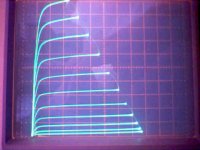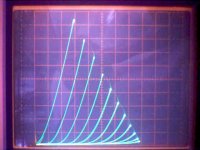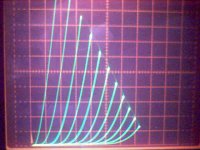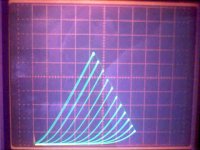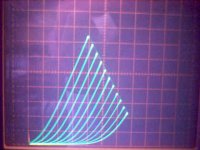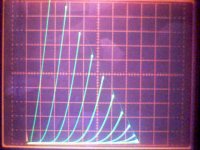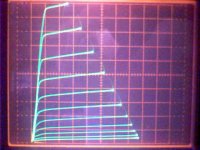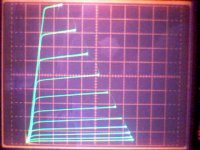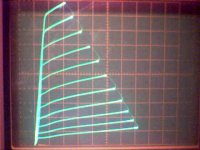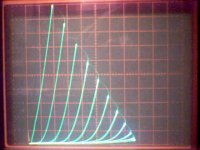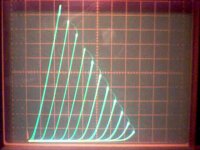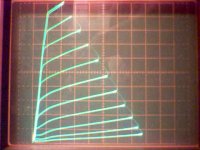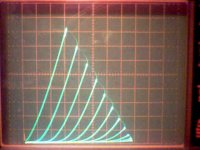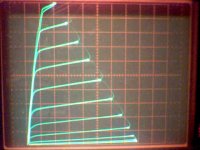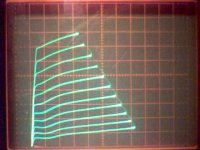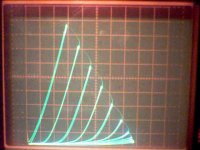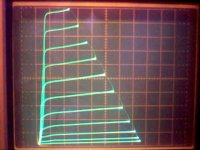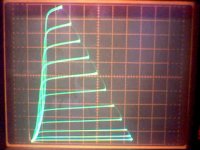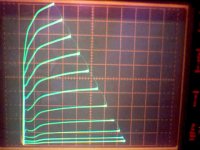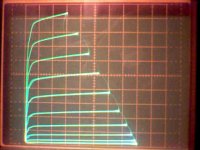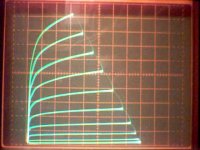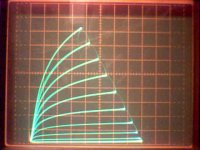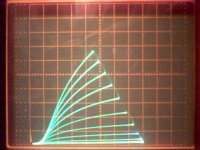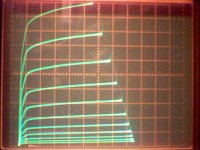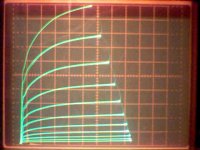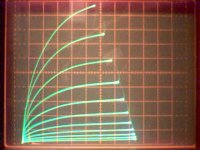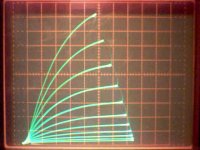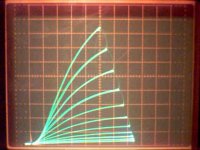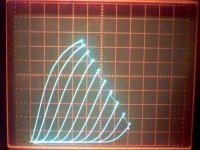Here is the 6F12P actual triode and then the pentode as triode again. My data sheet shows g3 attached to cathode internally.
Plot1: actual triode: 2 mA/div vert., 50 V/div horiz., .27 V steps on g1
Plot2: pentode config as triode: 2 mA/div vert., 50 v/div horiz., .27 V steps
on g1
Plot1: actual triode: 2 mA/div vert., 50 V/div horiz., .27 V steps on g1
Plot2: pentode config as triode: 2 mA/div vert., 50 v/div horiz., .27 V steps
on g1
Attachments
Here is 6485/6AH6WA, got these cheap on sale at $0.50 each
Plot1: pentode: 2 mA/div vert., 50V/div horiz., 100 V on g2, .27 V steps on
g1, 0 V on g3
Plot2: pentode: ditto, except +15V on g3
Plot3: triode config.: ditto, except 1.4 V steps on g1 and g3 = 0
Plot1: pentode: 2 mA/div vert., 50V/div horiz., 100 V on g2, .27 V steps on
g1, 0 V on g3
Plot2: pentode: ditto, except +15V on g3
Plot3: triode config.: ditto, except 1.4 V steps on g1 and g3 = 0
Attachments
Here is the high gm 12HL7
Plot1: pentode: 10 mA/div vert., 50 V/div. horiz., g2 100V, g1 steps .55V,
g3 0V
Plot2: triode config.: ditto, except 1.4V steps on g1
Plot1: pentode: 10 mA/div vert., 50 V/div. horiz., g2 100V, g1 steps .55V,
g3 0V
Plot2: triode config.: ditto, except 1.4V steps on g1
Attachments
Last edited:
Here is the high gm 12HG7
Plot1: pentode: 10 mA/div vert., 50 V/div horiz., g2 100V, .24 V steps on g1
g3 0V (not much effect on beamers usually)
Plot2: triode config. ditto, 1.4V steps on g1
Good tube! 😉
amparex amperex nos tube new in box 12gn7a 12hg7 - eBay (item 230401481544 end time Feb-16-10 17:34:59 PST)
Hi -
I just noticed these posts & am considering the possibility of using the suppressor grids in a 6BN11 as either a differential local feedback input or part of a bias control scheme (more likely the latter) for a balanced two stage DC coupled amplifier using 7189's as outputs. Are either of these options, or should I just tie the 6BN11 g3 grids to a fixed voltage and forget it about it?
Thanks for any responses.
I just noticed these posts & am considering the possibility of using the suppressor grids in a 6BN11 as either a differential local feedback input or part of a bias control scheme (more likely the latter) for a balanced two stage DC coupled amplifier using 7189's as outputs. Are either of these options, or should I just tie the 6BN11 g3 grids to a fixed voltage and forget it about it?
Thanks for any responses.
6BN11 is a beam pentode, which won't have much useful g3 effect. But here is what happens with 0V, -50V and +50V on g3:
(50V/div horiz., 2 mA/div vert., 90 V on g2, 0.27 V steps on g1)
A 6BV11 dual pentode has large g3 effects, but its quite a different tube. (like dual 6GY6)
(50V/div horiz., 2 mA/div vert., 90 V on g2, 0.27 V steps on g1)
A 6BV11 dual pentode has large g3 effects, but its quite a different tube. (like dual 6GY6)
Attachments
Hi -
Thanks much for running these curves. Now I know what not to try with the g3 on the 6BN11🙂 Problem is, while the 6BV11 is good for that, in other regards, it looks like a less desirable choice for audio use, judging from the linearity of its plate curves.
Well, I'll probably pick up a few 6BV11s just in case if I turn out to need this grid control.
Best regards
Thanks much for running these curves. Now I know what not to try with the g3 on the 6BN11🙂 Problem is, while the 6BV11 is good for that, in other regards, it looks like a less desirable choice for audio use, judging from the linearity of its plate curves.
Well, I'll probably pick up a few 6BV11s just in case if I turn out to need this grid control.
Best regards
"6BV11 is good for that, in other regards, it looks like a less desirable choice for audio use, judging from the linearity of its plate curves. "
Well, these dual control, or other multigrid control types are intended for use with a small signal, usually in the RF of IF of a receiver. They can be made linear over large signals if the g3 is adjusted positive enough (and gm about doubles over the data sheet value). But the g3 gain control effect reduces the high current low plate voltage end of the curves the most. Natural 2nd harmonic getting knocked out and 3rd and other odd harmonics growing big.
For more gm and watts, the 6LE8, demo'd earlier, works similarly.
for all plots: 50 V/div horiz., 2 mA/div vert., g2 at 100V, 0.55 V steps on g1
Plot1: 6BV11 with g3 at 0V
Plot2: 6BV11 with g3 at +2V
Plot3: 6BV11 with g3 at +8V
Plot4: 6BV11 with g3 at -2V
Well, these dual control, or other multigrid control types are intended for use with a small signal, usually in the RF of IF of a receiver. They can be made linear over large signals if the g3 is adjusted positive enough (and gm about doubles over the data sheet value). But the g3 gain control effect reduces the high current low plate voltage end of the curves the most. Natural 2nd harmonic getting knocked out and 3rd and other odd harmonics growing big.
For more gm and watts, the 6LE8, demo'd earlier, works similarly.
for all plots: 50 V/div horiz., 2 mA/div vert., g2 at 100V, 0.55 V steps on g1
Plot1: 6BV11 with g3 at 0V
Plot2: 6BV11 with g3 at +2V
Plot3: 6BV11 with g3 at +8V
Plot4: 6BV11 with g3 at -2V
Attachments
I just realized that the earlier 6LE8 plots were using g3 as the stepped control grid instead of g1. So here are comparable g1 stepped plots for 6LE8, similar to the 6BV11 ones shown above. The last plot reverts to g3 stepping for comparison. This last plot (g3 stepping) just grows or shrinks vertically if g2 or g1 are changed. So that mode may be useful for gain control of large signals. Only problem with this is that g3 for the signal has rather low gm, while g1 for the gain control has high gm.
Note: all 6LE8 plots thus far have been with the two plates connected together, and the two g3 connected together, so as to act as a single dual control pentode. Obviously, the split g3 and split plates are actually intended for operation in differential mode, ie, like dual pentodes with common cathodes with common g1 and common g2, but differential g3 and plates.
For plots 1 thru 5: 50 V/div horiz., 5 mA/div vert., 90 V on g2, 0.53 V steps on g1, g3 constant V as noted
Plot1: 6LE8 g3 at +12V
Plot2: 6LE8 g3 at +4V
Plot3: 6LE8 g3 at 0V
Plot4: 6LE8 g3 at -4V
Plot5: 6LE8 g3 at -8V
Plot6: 6LE8 with 5.5 V stepping on g3, g1 at 0V, g1 or g2 can be changed to control vertical height, ie act like a magnifier/shrinker.
If you observe the top curve of the g1 stepped plots (plots 1 thru 5) you will notice that it is sequentially tracing out the steps in plot 6.
Note: all 6LE8 plots thus far have been with the two plates connected together, and the two g3 connected together, so as to act as a single dual control pentode. Obviously, the split g3 and split plates are actually intended for operation in differential mode, ie, like dual pentodes with common cathodes with common g1 and common g2, but differential g3 and plates.
For plots 1 thru 5: 50 V/div horiz., 5 mA/div vert., 90 V on g2, 0.53 V steps on g1, g3 constant V as noted
Plot1: 6LE8 g3 at +12V
Plot2: 6LE8 g3 at +4V
Plot3: 6LE8 g3 at 0V
Plot4: 6LE8 g3 at -4V
Plot5: 6LE8 g3 at -8V
Plot6: 6LE8 with 5.5 V stepping on g3, g1 at 0V, g1 or g2 can be changed to control vertical height, ie act like a magnifier/shrinker.
If you observe the top curve of the g1 stepped plots (plots 1 thru 5) you will notice that it is sequentially tracing out the steps in plot 6.
Attachments
Last edited:
smoking-amp, lots of thanks for the nice plots! excellent job! still, i am keen to see, how a 6P15 or SV83, (not the EL83 = not the same beast) would react on suppressor voltage changes as it is said, to be more linear as a video tube.
"how a 6P15 or SV83"
Sorry, I don't have them. If they are beam types, then take a look at the 6BN11 curves above (ie, not much effect).
Sorry, I don't have them. If they are beam types, then take a look at the 6BN11 curves above (ie, not much effect).
6P15P is a real pentode, with G3 on a pin unconnected to cathode. 12W anode handling, quite close to EL84 in performance. But they spark over if you put them in the usual 350..380V PP guitar amps. The Orel ones do anyway.
This is the Pentode that started that curious discussion on cap-connecting G3:
http://www.diyaudio.com/forums/tubes-valves/153779-anyone-try-hazen-mod-g3-supressor-grid.html
This is the Pentode that started that curious discussion on cap-connecting G3:
http://www.diyaudio.com/forums/tubes-valves/153779-anyone-try-hazen-mod-g3-supressor-grid.html
Last edited:
Hmm, I do have some 29GK6 which are very close to EL84, and have a g3 connection. From swithcing the polarity of the power supply for g3 on other tubes I've had on the tracer, some don't do much and some go absolutely bonkers without g3 connected. I'll try to dig up a 29GK6 here. Ohh, I also have some 6HB6 tubes in both beam and non-beam form. I'll look for a non-beam one to try too.
- Home
- Amplifiers
- Tubes / Valves
- Suppresor Grid used for Feedback?
